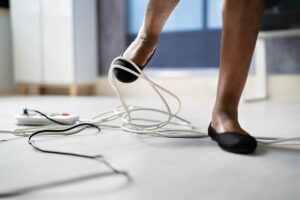
The first rule of accident survival is don’t have one. At the very least, know how to minimize the chances of one and, if you have one, know how to survive. Safety Education Officer Trooper Sean T. Ramsey has taught many of the state’s electric cooperative employees. Ramsey says there are four primary reasons for fatal vehicle accidents: high speed, drinking and driving, distracted driving (cell phones, etc.) and not wearing a seat belt.
Even if you survive an accident, because you and the other occupants in your car are wearing seat belts, there are dangers to be aware of if your accident involves a downed power line.
A car accident can happen quickly, yet the final seconds may seem to be in slow motion as the vehicle and its passengers jolt upon contact. Such an accident can inflict serious injury and damage, and when the car wreck involves power poles, there is an added danger.
After any wreck, it is natural for people to want to get out of the car to assess damage to themselves and the vehicle. However, when the wreck involves power poles and lines, that is the wrong thing to do.
In February 2016, a vehicle crashed with a utility pole in Lawrence, Kan. Fortunately, the Lawrence Journal-World reported law enforcement officials told the driver to stay in the car for his safety. The power pole had snapped and lines were in contact with the car and with a nearby wooden fence. In fact, the fence caught fire from the incident. Once the utility arrived on the accident scene and cut the power, the driver was able to safely exit the vehicle.
According to the Insurance Institute for Highway Safety, approximately 20 percent of car accident deaths result from a vehicle making contact with a fixed object such as a power pole. The U.S. Department of Transportation reports that, on average, auto accidents with power poles result in 1,000 deaths each year.
Should you be involved in an automobile accident with a power pole, Safe Electricity provides the following safety information:
• Stay in the car. Call 911 to have the utility notified.
• Do not leave the vehicle until utility professionals have
de-energized the line and they advise you that it is safe to do so.
• If you must exit the vehicle because it is on fire, jump clear of it with your feet together and without touching the vehicle and ground at the same time. Keeping your feet together, “bunny hop” to safety. Doing this will ensure that you will not have different strengths of electric current running from one foot to another.
• Be aware that, after an accident with a pole, wires can fall at any time.
• Downed lines can sometimes show they are live by arcing and sparking with electricity, but this is not always the case. Treat all downed wires as though they are energized.
• Remember, most power lines are not insulated. The coating on the lines is for weather proofing and will not offer any protection from the electrical current.

• The tires of the vehicle do not insulate it from electrical dangers. Follow the above safety precautions, even if the car has rolled and is upside down or on its side. The vehicle is the path to ground for the electrical current. So while you remain in the car, you are safe. If you step out of the car, you are in danger of becoming the path to ground.
Also be cautious if you witness an accident involving a vehicle and downed lines. Stay back, and warn others to stay away. Make sure the occupants of the car stay inside the vehicle until the utility has arrived to de-energize the lines.
For more information on electrical safety, visit SafeElectricity.org.







